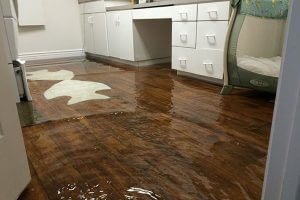
The first evidence of the glorious spring weather has come. Bears and humans alike are coming out of hibernation, snows are starting to melt, the sun is popping out and the days are getting just a bit warmer. With the spring weather comes the rains, snow melting, grounds softening and sometimes the unavoidable basement flooding. Sadly, most insurances do not cover the cost of ground water flooding in a basement, which can lead to extensive costs for water mitigation and repairs, and in turn leads to frustration.
Why do I have ground water?
There are multiple reasons as to why ground water might be rising in a basement. Reasons vary from sump pump failure to heavy rains through bulkhead doors to cracks in the foundation. Completing a visual examination of your basement can help to determine exactly why a basement is flooding.
What can I do to help prevent a flooding basement?
There are a multitude of precautionary maintenance that can be completed yearly or as needed to help prevent a flooding basement. A few of ServiceMaster Elite’s recommendations are below.
- Sump pump maintenance
One of the largest causes of flooding in a basement, is sump pump failure. If a storm is heading your way, it’s the perfect time to make sure the sump pump is working correctly and is properly plugged in. If you live in a rural area that loses power frequently, it might be time to invest into a generator as a back up power for your sump pump. If you don’t have a sump pump in your basement, it would be smart to invest into one. A sump pump can be a basements defense to water mitigation and mold mitigation.
If you do have a sump pump and the flooding occurs due to sump pump failure, you might check your insurance. Not all insurances cover it, but some insurances carry additional coverage for sump pump failure. It would be a good time to make sure you are potentially covered before the loss happens.
- Repair foundation cracks
So the basement is flooding, but the sump pump didn’t fail and the water didn’t come through the bulkhead, sounds like it’s time to check for foundation cracks and potentially have them repaired. Water likes to follow the path of least resistance, and cracks in the foundation are an open invitation for easy access to the basement. After completing a visual examination of the basement, you could fill any cracks that were found with epoxy. If, after filling the cracks, the basement continues to flood, it would be time to call a professional to inspect the cracks.
- Adjust your landscape
Oddly enough, if your yard is not properly landscaped, it can add to a flooding basement issue. Make sure your flower beds are sloping away from the house, rather than towards the house. Sloping towards the house or even a trench between the house and the flower bed can cause water to run into the basement or piling up next to the foundation wall and over time begin to seep in.
- Clean gutters and downspouts
Gutters or downspouts full of debris allows for water to pool up closely to the house, rather than flow freely away from the house. While cleaning the downspouts, make sure the water is coming out at least three feet away from the house. This can be done by utilizing extensions or troughs. Cleaning gutters and downspouts is a relatively easy way of ensuring that water is being moved away from the home and thus reducing the chance of the water entering the home.
My basement is full of water, what should I do?
- Move content
Move your content off the floor. Utilize crates, plastic tubs or pallets to lift the content out of the water, preventing further damage to the content and allowing the dry out process of the content to begin.
- Extract the water
Use a shopvac to begin extracting the water from the basement. The longer the water sits in the basement affecting building materials, the more damage occurs and the costlier the repairs will be.
- Call a water mitigation expert
Calling a water mitigation expert immediately can save you a lot of trouble. It may not save you on money, but it will save the hassle of trying to dry out the structure yourself. Keep in mind that just because you can’t see water anymore does not mean the building materials have been completely dried out. Utilizing a company, such as ServiceMaster Elite, helps to ensure that all building materials are properly dried out and secondary damages, such as mold growth, are prevented.
Being a homeowner is not a walk in the park. It’s a lot of constant work to keep it all together. Being a proactive homeowner can help to prevent many water or fire damages that might potentially occur. Proactive homeowners tend to be attentive to the workings of their home and can immediately notice when something small arises. Oftentimes the something small turns into something quite large if it goes unnoticed and unattended. Be a proactive homeowner and help prevent flooding in your basement this spring!
ServiceMaster Elite operates across New England and Florida. Is slated to be one of the largest individually-owned disaster restoration companies in the United States. ServiceMaster Elite is partnered with leading insurance companies, commercial and residential property management firms and homeowners to restore peace of mind after water or fire damage. Give us a call today, {F:P:Sub:Cookie:L:Phone}.

